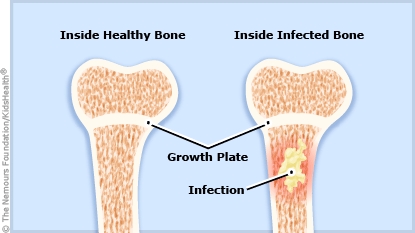Osteomyelitis: How to Care for Your Child
Osteomyelitis (ah-stee-oh-my-eh-LIE-tis) is the medical term for a bone infection. It happens when germs, usually bacteria, get in the bone. Several weeks of antibiotic treatment usually helps a bone infection heal. With treatment and close follow-up, most kids with osteomyelitis recover fully.


-
Your child should finish all the antibiotics as prescribed.
-
Follow any instructions your health care provider gave you about your child's physical activities.
-
Let your child rest when tired.
-
Schedule a follow-up visit. Your health care provider will want to see your child every 1–2 weeks to see how well the treatment is going.

Your child:

Your child has symptoms that return or get worse.

How does osteomyelitis happen? Osteomyelitis happens when germs (typically bacteria) get into a bone and cause an infection. Usually this happens when bacteria spread through the bloodstream to the bone. Bacteria also can spread to a bone from an infection that's near it, or get into a broken bone if there's a cut in the skin over it.
Osteomyelitis can happen in any bone, but it most often affects arm and leg bones.
How is osteomyelitis treated? Children with osteomyelitis are usually treated in a hospital for at least a few days. They get IV antibiotics (given into a vein through a tube) to fight the infection. When the infection starts to get better, most kids can switch to medicine taken by mouth. A surgeon may remove infected bone tissue. Some kids get a splint or cast to support the affected bone.
Can osteomyelitis be prevented? Because osteomyelitis is usually caused by bacteria, one way to help prevent it is to keep skin clean. All cuts and wounds — especially deep wounds — should be cleaned well. Wash a wound with soap and water, holding it under running water for at least 5 minutes to flush it out. Parents and kids should wash their hands well and often to stop the spread of germs. Kids also should be up to date on their vaccinations.